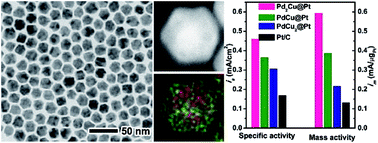Enhanced oxygen reduction activity of Pt shells on PdCu truncated octahedra with different compositions†
Abstract
Pd@Pt core–shell nanocrystals with ultrathin Pt layers have received great attention as active and low Pt loading catalysts for oxygen reduction reaction (ORR). However, the reduction of Pd loading without compromising the catalytic performance is also highly desired since Pd is an expensive and scarce noble-metal. Here we report the epitaxial growth of ultrathin Pt shells on PdxCu truncated octahedra by a seed-mediated approach. The Pd/Cu atomic ratio (x) of the truncated octahedral seeds was tuned from 2, 1 to 0.5 by varying the feeding molar ratio of Pd to Cu precursors. When used as catalysts for ORR, these three PdxCu@Pt core–shell truncated octahedra exhibited substantially enhanced catalytic activities compared to commercial Pt/C. Specifically, Pd2Cu@Pt catalysts achieved the highest area-specific activity (0.46 mA cm−2) and mass activity (0.59 mA μgPt−1) at 0.9 V, which were 2.7 and 4.5 times higher than those of the commercial Pt/C. In addition, these PdxCu@Pt core–shell catalysts showed a similar durability with the commercial Pt/C after 10 000 cycles due to the dissolution of active Cu and Pd in the cores.



 Please wait while we load your content...
Please wait while we load your content...